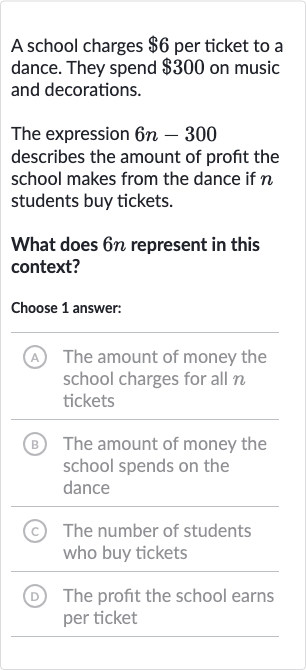AI tutor
Welcome to Bytelearn!
Let’s check out your problem:

A school charges per ticket to a dance. They spend on music and decorations. The expression describes the amount of profit the school makes from the dance if students buy tickets. What does represent in this context?Choose answer:(A) The amount of money the school charges for all tickets(B) The amount of money the school spends on the dance(C) The number of students who buy tickets(D) The profit the school earns per ticket
Full solution
Q. A school charges per ticket to a dance. They spend on music and decorations. The expression describes the amount of profit the school makes from the dance if students buy tickets. What does represent in this context?Choose answer:(A) The amount of money the school charges for all tickets(B) The amount of money the school spends on the dance(C) The number of students who buy tickets(D) The profit the school earns per ticket
- Given Expression Breakdown: We are given an expression , which represents the profit made by the school from a dance event. To understand what represents, we need to break down the expression.
- Ticket Revenue Calculation: The school charges per ticket, and represents the number of students who buy tickets. Therefore, represents the total amount of money collected from selling tickets.
- Identification of : Since the expression for profit is , and we know that is spent on music and decorations, the must represent the revenue from ticket sales before expenses are subtracted.
- Matching to Options: Now, we can match to the correct choice from the given options:(A) The amount of money the school charges for all tickets(B) The amount of money the school spends on the dance(C) The number of students who buy tickets(D) The profit the school earns per ticket
- Final Correspondence: Clearly, corresponds to choice (A) because it is the total amount charged for all tickets, not the amount spent, the number of students, or the profit per ticket.
More problems from Interpreting Linear Expressions
QuestionGet tutor help
